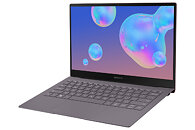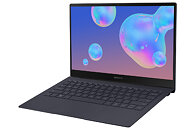- Joined
- Oct 9, 2007
- Messages
- 46,354 (7.68/day)
- Location
- Hyderabad, India
| System Name | RBMK-1000 |
|---|---|
| Processor | AMD Ryzen 7 5700G |
| Motherboard | ASUS ROG Strix B450-E Gaming |
| Cooling | DeepCool Gammax L240 V2 |
| Memory | 2x 8GB G.Skill Sniper X |
| Video Card(s) | Palit GeForce RTX 2080 SUPER GameRock |
| Storage | Western Digital Black NVMe 512GB |
| Display(s) | BenQ 1440p 60 Hz 27-inch |
| Case | Corsair Carbide 100R |
| Audio Device(s) | ASUS SupremeFX S1220A |
| Power Supply | Cooler Master MWE Gold 650W |
| Mouse | ASUS ROG Strix Impact |
| Keyboard | Gamdias Hermes E2 |
| Software | Windows 11 Pro |
Samsung Electronics today announced the availability of Galaxy Book S with Intel processor, the latest addition to its leading computing device family. To ensure consumers have access to a wide range of computing devices to best fit their lifestyle, Samsung introduces the Galaxy Book S powered by the new dynamic Intel Core processor with Intel Hybrid Technology. Galaxy Book S joins other previously announced premium mobile laptops, designed to offer a seamless and connected experience across devices. Galaxy Book S is built for the next generation of users who are looking for a computing device that provides outstanding productivity, wide-ranging connectivity, enhanced mobility and expansive continuity across devices and operating systems to help them get more done in less time.
"The way we work has shifted and it's important we have computing devices that can adapt to this new working style. Users utilize multiple devices throughout their day to accomplish tasks, and demand that those devices provide them with enough flexibility to remain on the move and available," said Woncheol Chai, SVP and Head of Product Planning Team, Mobile Communications Business, Samsung Electronics. "With our new computing devices like the Galaxy Book S, we are providing users with an exciting opportunity to be productive, efficient and connected."



Dynamic Performance
To improve performance and efficiency, Galaxy Book S features an impressively designed internal component setup powered by the new Intel Core processor with Intel Hybrid Technology. Galaxy Book S is the first ever device to offer this unique processor with Intel's Foveros 3D stacking technology and a hybrid CPU architecture. With this processor, Galaxy Book S efficiently provides an exceptional laptop performance. The processor delivers full Windows 10 application compatibility and intelligently balances multiple high-performing processes during use while conserving battery when not in use, powering your creative, commerce and business programs. Galaxy Book S features a long-lasting battery and offers up to 512 GB of storage, so you don't have to waste time worrying about losing power or running out of space.
"The introduction of Samsung Galaxy Book S, the first device to offer the Intel Core processor with Intel Hybrid Technology, builds on our long history with Samsung. Today, we showcase what can be achieved when we bring great engineering talent together to work towards a united vision for new computing experiences of the future," said Chris Walker, vice president and general manager of Mobile Client Platforms at Intel.
Always Ready Connectivity
With Samsung's new computing devices, you can enjoy nonstop connectivity. Galaxy Book S features Wi-Fi 6 (Gig+), the next generation of Wi-Fi that empowers efficient, speedy internet without competing for a network connection with other devices, while always-on LTE3 lets you enjoy gigabit internet access without searching for a network. When you need to access your device immediately, Galaxy Book S' instant touch-to-wake capability ensures you can reach important files, share videos and respond to texts within seconds.
Design That Works Everywhere
The Galaxy Book S is designed for taking with you and carrying around all day. Lightweight at just 950 g and only 11.8 mm at its thickest point, the ultra-slim profile means you can slip the Galaxy Book S into a small bag, portfolio or just carry under your arm with ease. A fan-less design allows the Galaxy Book S to be slimmer than traditional laptops and helps it to run noiselessly, even during sustained and intense periods of work. Galaxy Book S features a light clamshell design built with a durable metal body, so you can have the stability you need on a desk or on your lap. If you're looking to get some fresh air while scrolling, Outdoor Mode on Galaxy Book S will instantly boost brightness to 600 nits using a two-key shortcut. With a bright screen that also supports touch interactions, you will feel more connected to your device than ever and free take advantage of seamless and productive working style.
Uninterrupted Device-to-Device Continuity
The new Galaxy computing devices like the Galaxy Book S unify the computing experience with seamless connectivity between devices. Thanks to our partnership with Microsoft, you can enjoy your favorite Android operating system on your Windows PC for a seamless and continuous device-to-device experience. With Microsoft's Your Phone feature, you can sync your mobile device to receive notifications, messages, cross-device copy & paste and photo transfer, all on your Galaxy Book S device.
Galaxy Book S is available in two shades, Earthy Gold and Mercury Gray.

View at TechPowerUp Main Site
"The way we work has shifted and it's important we have computing devices that can adapt to this new working style. Users utilize multiple devices throughout their day to accomplish tasks, and demand that those devices provide them with enough flexibility to remain on the move and available," said Woncheol Chai, SVP and Head of Product Planning Team, Mobile Communications Business, Samsung Electronics. "With our new computing devices like the Galaxy Book S, we are providing users with an exciting opportunity to be productive, efficient and connected."



Dynamic Performance
To improve performance and efficiency, Galaxy Book S features an impressively designed internal component setup powered by the new Intel Core processor with Intel Hybrid Technology. Galaxy Book S is the first ever device to offer this unique processor with Intel's Foveros 3D stacking technology and a hybrid CPU architecture. With this processor, Galaxy Book S efficiently provides an exceptional laptop performance. The processor delivers full Windows 10 application compatibility and intelligently balances multiple high-performing processes during use while conserving battery when not in use, powering your creative, commerce and business programs. Galaxy Book S features a long-lasting battery and offers up to 512 GB of storage, so you don't have to waste time worrying about losing power or running out of space.
"The introduction of Samsung Galaxy Book S, the first device to offer the Intel Core processor with Intel Hybrid Technology, builds on our long history with Samsung. Today, we showcase what can be achieved when we bring great engineering talent together to work towards a united vision for new computing experiences of the future," said Chris Walker, vice president and general manager of Mobile Client Platforms at Intel.
Always Ready Connectivity
With Samsung's new computing devices, you can enjoy nonstop connectivity. Galaxy Book S features Wi-Fi 6 (Gig+), the next generation of Wi-Fi that empowers efficient, speedy internet without competing for a network connection with other devices, while always-on LTE3 lets you enjoy gigabit internet access without searching for a network. When you need to access your device immediately, Galaxy Book S' instant touch-to-wake capability ensures you can reach important files, share videos and respond to texts within seconds.
Design That Works Everywhere
The Galaxy Book S is designed for taking with you and carrying around all day. Lightweight at just 950 g and only 11.8 mm at its thickest point, the ultra-slim profile means you can slip the Galaxy Book S into a small bag, portfolio or just carry under your arm with ease. A fan-less design allows the Galaxy Book S to be slimmer than traditional laptops and helps it to run noiselessly, even during sustained and intense periods of work. Galaxy Book S features a light clamshell design built with a durable metal body, so you can have the stability you need on a desk or on your lap. If you're looking to get some fresh air while scrolling, Outdoor Mode on Galaxy Book S will instantly boost brightness to 600 nits using a two-key shortcut. With a bright screen that also supports touch interactions, you will feel more connected to your device than ever and free take advantage of seamless and productive working style.
Uninterrupted Device-to-Device Continuity
The new Galaxy computing devices like the Galaxy Book S unify the computing experience with seamless connectivity between devices. Thanks to our partnership with Microsoft, you can enjoy your favorite Android operating system on your Windows PC for a seamless and continuous device-to-device experience. With Microsoft's Your Phone feature, you can sync your mobile device to receive notifications, messages, cross-device copy & paste and photo transfer, all on your Galaxy Book S device.
Galaxy Book S is available in two shades, Earthy Gold and Mercury Gray.

View at TechPowerUp Main Site




